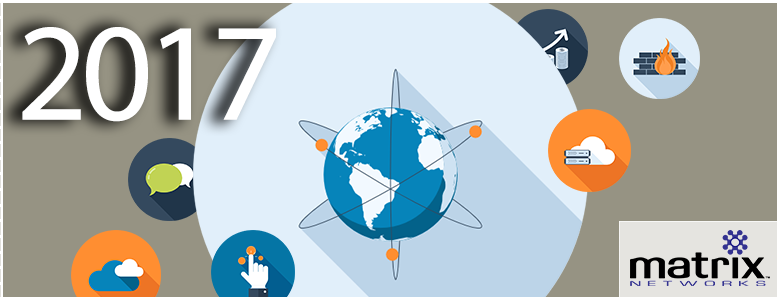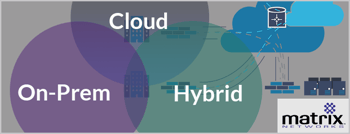
The biggest technology trends, mergers, and acquisitions from 2017.
Every year our technology ebbs and flows bringing new tools, trends and ideas to the forefront for business and consumers alike. In 2017 many things changed for business technology, making it difficult for most of us to keep up. Between mergers, acquisitions, software defined tech and net neutrality not a single month went by without disruptive changes. So, without further ado, let's dive into to a few highlights of the last year!
Industry Trends in 2017
- SD-WAN – Carriers and the businesses they support are rapidly adopting this technology and ditching the legacy networks that have been holding them down. This becomes a no brainer when you consider it provides increased reliability, speed, finite control/visibility and better performance for cloud applications.
- Application Integrations - APIs have already become a critical evaluation point for new Enterprise tech. Our applications must communicate to reduce complexity, maximize profit and ensure the best customer experience. Services like Zapier enable integrations between practically any two cloud-based tools. Companies like Microsoft, Slack, Twillio, OKTA, SalesForce.com and RingCentral are building platforms designed specifically for integrations enabling their customers to truly simplify tech for the users.
- IT budgets - The size of IT budgets continues to shrink, with maintenance and staffing comprising the majority. This has led to technology adoption driven by specific line of businesses like sales/marketing, operations or accounting. IT teams are forced to support what comes their way with less input on product selection, and fewer resources.
- Internet of Things (IoT) - This technology still undelivered for most businesses. The technology shows promise and has grown in specific industries like State Farms use of sensors in driver's cars to prove safe driving and reduce premiums. Most IoT devices are simply sensors, like those used to identify missing manholes in New York City.
- Net Neutrality - The end of Net Neutrality is likely to have huge impacts on the web as we know it. The rate of development is likely to slow as start-ups struggle to compete with established enterprises. These start-ups have been fueling tech growth for the last decade, which means growth will likely be stifled by this decision. The upside is that specific services that need QoS over public internet, like voice and video could see an improvement with prioritization, but will likely push costs up.
Major Mergers and Acquisitions in 2017
- Cisco – Cisco has seen the writing on the wall, swooping up leaders in cloud based technology like candy canes on Christmas.
- Broadsoft for $1.9B is a huge deal. The software provided by Broadsoft is the underlying technology for most carrier cloud voice offerings. This immediately gives Cisco a valid cloud offering for voice to compete with companies like RingCentral, 8x8 and Vonage that have seen huge growth over the last 36 months.
- Viptela – This SD-WAN player was poised to compete with Velocloud as the SD-WAN path becomes more popular. Cisco now has a competitive product that will help standardize SD-WAN and provides validation of this growing technology space.
- AppDynamics – Provides an applications for management of SaaS apps and related infrastructure.
- Mitel buys ShoreTel - Consolidation of the legacy hardware voice providers, giving Mitel a strong software platform to build on their cloud strategy.
- Level 3 Merges with Centurylink – This move combines one of the largest backbones in Level 3 with over 250,000 miles of fiber from Centurylink in the US alone.
- HP Enterprise buys Nimble - In an attempt to stay relevant, HPE bought Nimble, the strongest new player in the storage space.
The 2017 Tech Takeaways
Enterprise technology is in flux as the legacy players like HP, Cisco and Mitel attempt to compete with their nimbler adversaries. Technology advancement has been driven by innovative companies like Slack, Meraki (now Cisco), VeloCloud, 8x8, RingCentral, and SalesForce.com. Despite the chatter about AI and IoT, growth in these IT challengers continues to be driven by integrations, pre-built or API driven and simplicity to use and deploy. For business owners, this is a positive trend as the complexity of managing a business and overhead decrease with well-integrated easy to use tools. The giants that have squeezed their clients for every penny while providing very little added value are scrambling to keep up, acquiring those that are beating them and trying to adapt the technology to their go to market strategies.
Furthermore, MPLS and other private networks are losing their value as the networks perimeter has been torn down by cloud applications and mobile employees, driving the need for new security measures. This pattern of cloud migration and decreased reliance on traditional private networks opens the doors to commodity internet with SD-WAN optimization. 2018 is sure to bring new trends, and growth in other spaces, but one thing is for sure cloud-based applications are having a large impact in the way businesses buy, scale, and differentiate. Understanding how to take advantage of emerging technology is critical to the competitive status of every business.
Author: Kyle Holmes




.svg%20(1).png?width=55&name=1200px-Logo_of_YouTube_(2015-2017).svg%20(1).png)

